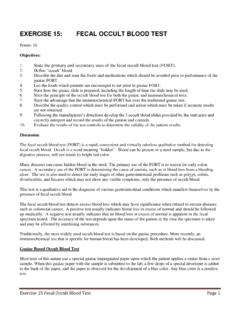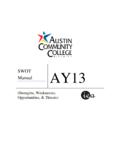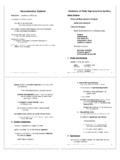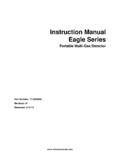Transcription of Unit: Total and Direct Bilirubin
1 MLAB 2401 - Clinical Chemistry Lab Manual C F 113 UNIT: Total and Direct of Total and Direct completion of this exercise, the student will be able formation, excretion, and clinical significance of Direct , indirect and Total a Total Bilirubin a Direct Bilirubin so many other substances measured in clinical chemistry laboratories, Bilirubin is a wasteproduct. Bilirubin , the principle pigment in bile, is derived from the breakdown of several degradation steps, the free Bilirubin becomes bound by albumin and is transportedthrough the blood to the liver. This Bilirubin is not soluble in water, and is referred to as insoluble,indirect, or unconjugated. In the liver, Bilirubin is rendered soluble by conjugation withglucuronide. The water-soluble Bilirubin , called Direct or conjugated, is transported along withother bile constituents into the bile ducts, then to the intestines. In the intestines, bacterial enzymeaction converts Bilirubin to several related compounds, collectively referred to as methods for Bilirubin estimation were based on measurement of its oxidation product,biliverdin or on assessment of the icteric index.
2 Introduction of the diazo reaction for Bilirubin byvan den Bergh in 1918 led to its widespread adoption for quantitating the pigment in serum. Vanden Bergh and Muller found that Bilirubin in normal serum reacted with Ehrlich's diazo reagent(diazotized sulfanilic acid) when alcohol was added. Their observation that bile pigment reactedwith the diazo reagent without the addition of alcohol led to the recognition that some change inbilirubin had been affected by the that reacts with the diazo reagent without the addition of alcohol is called Direct orconjugated while the form that reacts only in the presence of alcohol is called indirect low concentration of Bilirubin is found in normal plasma, almost all of which is indirect. The sumof the Direct and indirect forms (or conjugated and unconjugated) is termed Total Bilirubin . Routineanalytical procedures exist for the determination of Total Bilirubin and for the measurement ofdirect Bilirubin .
3 The indirect fraction is obtained by subtracting the Direct value from the totalvalue. The determination of Direct as well as Total Bilirubin is used in differentiating certain typesof SignificanceAny increase in formation or retention of Bilirubin by the body may result in jaundice, a conditioncharacterized by an increase in the Bilirubin level in the serum and the presence of a yellowishpigmentation in the may be classified as prehepatic, hepatic, or post-hepatic. In prehepatic jaundice, excessbilirubin production (hemolysis) is responsible. Hepatic jaundice occurs when either the removalof Bilirubin from the blood or conjugation of Bilirubin by the liver is defective. This can haveUNIT: Total and Direct Bilirubin (continued)F 114 C MLAB 2401 - Clinical Chemistry Lab Manualorganic or genetic causes. Post-hepatic jaundice refers to anatomic obstruction of the extra-hepatic biliary tree. The most common causes of jaundice are liver disease and blockage of thecommon bile duct.
4 It is necessary to distinguish between the causes of jaundice early in thedisease prior to the onset of complications, as the course of treatment is dependent on the causeof the jaundice is caused by overproduction of Bilirubin due to excessive hemolysis and theinability of the liver to adequately remove this pigment from the blood. This condition is usuallyassociated with elevated values of serum indirect of the liver and infectious or toxic hepatitis are caused by some type of intrahepaticobstruction, where production of Bilirubin is not increased, but accumulates and is discharged backinto the blood. In these conditions, the indirect form of Bilirubin predominates in the early phase,but as liver damage progresses the Direct form also becomes jaundice, caused by a post-hepatic blockage of the larger bile passages, particularlythe common bile duct, results in a reflux of Bilirubin into the blood. This condition, whenuncomplicated, is associated with elevated serum Bilirubin only of the Direct of Total Bilirubin and determination of the Direct and indirect fractions is importantin routine screening for and the differential diagnosis of for Bilirubin determination should be protected from light, since Bilirubin is light-sensitive and will break down under of den Bergh, Malloy and Evelyn Reaction In an aqueous solution, Ehrlich's diazoreagent reacts with the Direct Bilirubin in the serum to form a pink to reddish-purple coloredcompound (azobilirubin).
5 It is read at one minute. In a 50% methyl alcohol solution, Ehrlich'sdiazo reagent reacts with the Total Bilirubin in the serum to form a pink to reddish-purplecolored compound. (Read at 30 minutes.) of Jendrassik and Grof Serum or plasma is added to a solution of sodiumacetate and caffeine-sodium benzoate. The sodium acetate buffers the pH of the diazoreaction, while the caffeine-sodium benzoate accelerates the coupling of Bilirubin withdiazotized sulfanilic acid. The azobilirubin color develops within 10 minutes. (Anaccelerating agent facilitates the coupling of albumin-bound Bilirubin with the diazo reagent.) The ASTRA System Direct Bilirubin Chemistry Module employs a modification ofthe Jendrassik-Grof rate Bilirubin Conjugated Bilirubin reacts with DSA under acid conditions toform a red chromophore. The absorbance due to the chromophore is directlyproportional to the conjugated Bilirubin in the sample and is measured using a two-filter(540-600 nm) end point Bilirubin + DSA + H 6 Red chromophore+(non-absorbing at 540 nm) (absorbs at 540 nm)UNIT: Total and Direct Bilirubin (continued)MLAB 2401 - Clinical Chemistry Lab Manual C F Bilirubin Total Bilirubin reacts with DSA under acid conditions to form a redchromophore.
6 Lithium dodecyl sulfate (LDS) is employed to solubilize the unconjugatedbilirubin. The absorbance due to the chromophore is directly proportional to the bilirubinin the sample and is measured using a two-filter (540-600 nm) end point + DSA + H Red chromophore+ LDS (non-absorbing at 540 nm) (absorbs at 540 nm) Bilirubin (up to 21 days) The absorbance of the sample, measured using atwo-filter (452-540 nm) differential technique is directly proportional to the bilirubinconcentration. Absorbance at 452 nm is due to the Bilirubin concentration, and, ifpresent, hemoglobin. At 540 nm, Bilirubin does not absorb, while hemoglobin exhibitsthe same absorbance as it does at 452 nm. The use of 540 nm as the blankingwavelength thus eliminates any hemoglobin contribution from the Total absorbance at452 in newborn babies can be read in this Direct spectrophotometric procedure inpart due to the fact that the normal range is much higher than for adults.
7 In addition,carotene and other dietary pigments prevent adult and specimens from older childrenfrom being suitable. ProcedureTotal and Direct Bilirubin (Sigma #605) Quantitative, ColorimetricPrinciple of ReactionBilirubin is coupled with diazotized sulfanilic acid to form azobilirubin. The color of this derivativeis pH dependent, occurring as pink in acid or neutral medium and blue under alkaline (conjugated) Bilirubin couples with diazotized sulfanilic acid (p-diazobenzenesulfonic acid),forming a blue color at alkaline pH.> blue color azobilirubinDirect Bilirubin (conjugated) + diazotized sulfanilic acid alkaline pH Indirect (unconjugated) Bilirubin is diazotized only in the presence of an accelerating agent,caffeine-benzoate-acetate mixture. Thus, the blue azobilirubin produced in mixtures containing accelerating agent originates from both the Direct and Indirect fractions and reflects the Totalbilirubin Bilirubin + caffeine-benzoate-acetate mixture + diazotized sulfanilic acid 6 azobilirubinSupplies and reagent (caffeine, sodium benzoate, sodium acetate) tartrate CAUTION: Strong base.
8 Avoid contact with skin and : Total and Direct Bilirubin (continued)F 116 C MLAB 2401 - Clinical Chemistry Lab ( N) Reagent (sulfanilic acid, sodium nitrite). Reconstitute one vial Diazo with mL five days at 2-6 Reagent. Prepare by adding mL DIHO. Cap, shake. Stable three months(room temperature) in the reference. Assayed dry preparation containing Bilirubin in a protein base for use asa control or for calibration purposes. The actual Bilirubin concentration appears on the , controls (2), and Collection and Storage Fresh serum is recommended, but heparinized plasma is also acceptable. Specimens must beprotected from both artificial light and sunlight during processing and storage as Bilirubin willundergo auto-oxidation to The use of a serum blank eliminates interference fromhemolysis and of Calibration Bilirubin reference with mL water. Let stand for several minutes and swirlor invert to three test tubes and pipet solutions as indicated in the chart belowTube # Bilirubin ReferenceWaterDilutionMultiplicationFact or (F) Bilirubin (mg/dL) - (F)x listed valueof mL each tube add in the sequence shown: (mix after each addition) mL caffeine mL diazo mL cysteine mL alkaline solutions to cuvets and record absorbance of all tubes using water as a referenceat 600 nm.
9 (Read within 30 minutes.) the Bilirubin concentrations for each tube by multiplying the listed value for thebilirubin reference by the appropriate dilution factor and : Total and Direct Bilirubin (continued)MLAB 2401 - Clinical Chemistry Lab Manual C F a calibration curve of the absorbance vs. screening purposes, the serum blank may be omitted, since the contribution by serumto the final absorbance in this procedure is generally minor. serum blank should be included primarily when assaying highly turbid sera or control orgrossly hemolyzed are not significantly affected by hemoglobin concentrations up to 280 the serum blank is omitted, the Total and Direct Bilirubin tubes are read versus wateras a up Blank tube only on specimens that are hemolyzed or lipemic. appropriately labeled test tubes add the reagent to cuvets and read absorbance of all tubes, including blank using DI water as areference at 600 the prepared calibration curve to determine the concentration of your unknown Total and Direct Bilirubin levels from the curve.
10 The indirect Bilirubin is thedifference between the Total and the Direct . Record all results on mg/dL UNIT: Total and Direct Bilirubin (continued)F 118 C MLAB 2401 - Clinical Chemistry Lab ManualUNIT: Total and Direct Bilirubin (continued)MLAB 2401 - Clinical Chemistry Lab Manual C F 119 Name Date Bilirubin CurveWavelength _____Linearity_____Spectrophotometer Used _____Identification AbsorbanceReference Concentration Value *Standard Tube 1 _____Standard Tube 2 _____Standard Tube 3 _____* see Preparation of Calibration Bilirubin IdentificationBlank sAbsorbanceTest sAbsorbanceCorrectedAbsorbanceConcentrat ion (units)Control 1 _____Control 2 _____Calculation formula(s) and Bilirubin IdentificationBlank sAbsorbanceTest sAbsorbanceCorrectedAbsorbanceConcentrat ion (units)Control 1 _____Control 2 _____Calculation formula(s) and examplesUNIT.
















